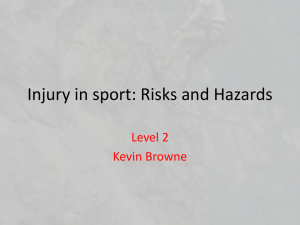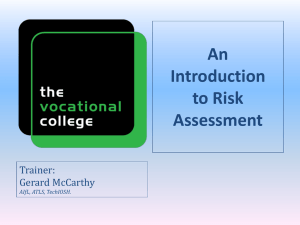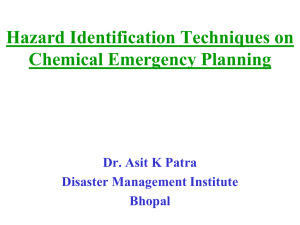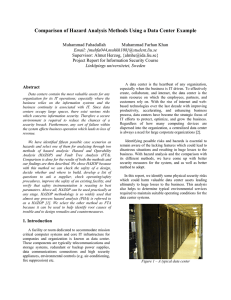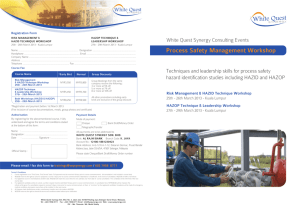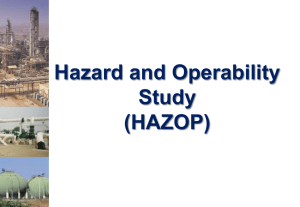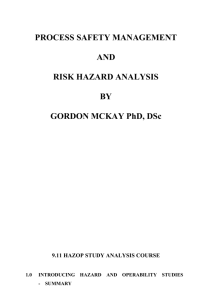Chemical-Process-Safety - Bangladesh University of
advertisement
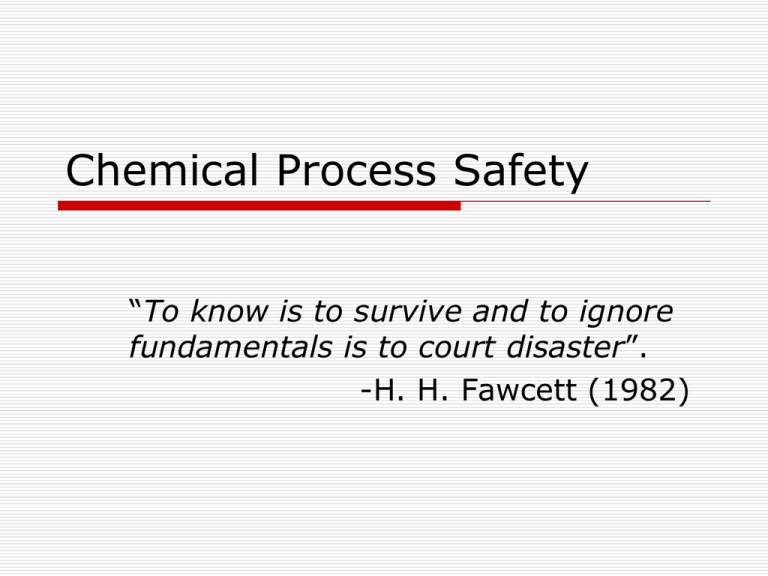
Chemical Process Safety “To know is to survive and to ignore fundamentals is to court disaster”. -H. H. Fawcett (1982) Definitions Safety/loss prevention: the prevention of accidents through the use of appropriate technologies to identify the hazards of chemical plant and eliminate them before an accident occurs. Hazard: a chemical or physical condition that has the potential to cause damage to people, property, or the environment. Risk: a measure of human injury, environmental damage, or economic loss in terms of both the incident likelihood and the magnitude of loss and injury. Safety Programs System Attitude Fundamentals Experience Time You Safety Programs cont’d A Good safety program identifies and eliminates existing safety hazards An Outstanding safety program has management system that prevent existence of safety hazards AIChE Code of Professional Ethics: Fundamental Principles Engineers shall uphold and advance the integrity, honor, and dignity of the engineering profession by Using their knowledge and skill for the enhancement of human welfare Being honest and impartial and serving with fidelity the public, their employers and clients Striving to increase the competence and prestige of the engineering profession AIChE Code of Professional Ethics: Fundamental Canons Engineers shall hold paramount the safety, health and welfare of the public in the performance of their professional duties Engineers shall perform services only in areas of their competence Engineers shall issue public statements only in an objective and truthful manner Engineers shall continue their professional development throughout their careers and shall provide opportunities for the professional development of those engineers under their supervision. Types of Chemical Plant Accidents Type of accidents Probability of occurrence Potential for fatalities Potential for economic loss Fire High Low Intermediate Explosion Intermediate Intermediate High Toxic release Low High Low Statistics Acceptable Risk & Public Perceptions We cannot eliminate risk entirely In a single Chemical Process plant the risk becomes too high because of multiple exposure to several processes Modern site layout requires sufficient separation of plants within site to minimize multiple exposure Public perception about hazards of chemicals can be confusing and may not reflect the real situation Japan’s Nuclear Crisis: 11 March, 2011 Bangladesh Electricity consumption (2003) 16,196 GW·h Fukushima I (Daiichi) Nuclear Power Plant Annual generation 29,891 GW·h Nuclear Reactor What Happened? The earthquake caused all operating reactors to automatically shut down (control rods are inserted, which stop the nuclear fission reaction by absorbing neutrons) Emergency diesel generators, which started to run the cooling system after the electrical power grid failed, shut down about an hour after the earthquake When cooling fails in a fully operational reactor or shortly after shutdown, the water quickly boils off creating increasing steam pressure in the core containment vessel and exposing the dry fuel assembly to increasing temperatures and radiation. The zirconium metal assembly reacts with the steam to give hydrogen and oxygen, an explosive mix Responses to the Threat First, the plant’s operators attempted to pump cold sea water directly into the reactors to replace the boiled-off coolant water. (Sea water is very corrosive and will undoubtedly damage the metal parts of the reactor, and its complex mixture of contents will also complicate the cleanup. This means to never running it again without a complete replacement of its hardware. As an added precaution, the seawater was spiked with a boron compound in order increase the absorption of neutrons within the reactor). Next, the bleeding off of some pressure from the reactor vessel in order to lower the risk of a catastrophic failure. (This was also an unappealing option, given that the steam would necessarily contain some radioactivity. Still, it was considered a better option than allowing the container to burst) Design Errors The electrical rooms at these plants are at the basements Although the plant was ready for an extreme event, it clearly wasn’t designed with a tsunami in mind—it is simply impossible to plan for every eventuality. However, this seems to be a major omission given the plant’s location. It also appears that the fuel storage areas weren’t nearly as robustly designed as the reactors Design Errors (cont’d) However it is human nature for the less immediate backup systems to be not well designed or maintained as the primary backups, one example is the temporary holding ponds. temporary storage pool for reactor #4 to which the fuel had been transferred while maintenance is performed is a much smaller one near the top the reactor. Unlike the 15-metre deep permanent storage pools Another example is that the backup portable generators – planned for when the batteries were exhausted – which is the 3rd (or 4th ) backup for power generation – had the wrong connectors and so could not be used Case History 1: ( Washington DC, Manufacturing Chemists’ association) Static Electricity :Tank car loading explosion Two plant operators were filling a tank car with vinyl acetate. After few seconds the contents of the tank exploded, one operator died from fractured skull and body burns Caused by a static spark jumped from the steel nozzle to the tank car Case History 2: ( Washington DC, Manufacturing Chemists’ association) Chemical Reactivity Bottle of isopropyl ether; A chemist twisted the cap of a bottle of isopropyl ether to open it. As the cap broke loose, the bottle exploded. The man died due to massive internal hemorrhage. Caused by rapid decomposition of peroxides, which formed in the ether while the bottle sat in storage. Case History 3: ( Washington DC, Manufacturing Chemists’ association) System Design Ethylene oxide explosion: A process storage tank contained 6500 gal of ethylene oxide. It was accidentally contaminated with ammonia. The tank ruptured and dispersed ethylene oxide into the air. A vapor cloud was formed and immediately exploded. One person was killed and nine were injured; property losses $16.5 million Lack of design protection to prevent back up of ammonia into the storage tank. Case History 4: ( Washington DC, Manufacturing Chemists’ association) System Procedure Man working in a Vessel: two maintenance workers were replacing part of a ribbon in a large ribbon mixer. The main switch was left energized, the mixer was stopped with one of three start-stop buttons. The operator by mistake pushed one of the start stop button , the mixer started and the mechanic inside was killed. Example of Disaster: Bhopal, India (December 3, 1984) Plant Location: Madhya Pradesh, central India; nearest inhabitants were 1.5 miles away, but a shanty town grew nearby. Produced Pesticides; owned by Union Carbide and partially owned locally Intermediate compound methyl iso-cyanate (MIC): reactive, toxic, volatile, flammable and vapor heavier than air. MIC unit was not operating because of labor dispute Example of Disaster cont’d Accident: Storage tank containing large amount of MIC became contaminated by water, heated by reaction; vapor traveled through pressure relief system into a scrubber and flare system that was not operating 25 tons toxic MIC vapor released, spread to the adjacent town killing over 2000 civilians and injuring 20,000 more. No plant workers were killed. Recommendation: Alternative reaction scheme or redesigning of the process with reduced inventory of MIC (less than 20 pounds) CO2 Stripper Failure of UFFL1991 (Ghorashal) CO2 stripper contains carbamate solution,CO2 and ammonia and runs under high pressure Stripper column exploded and split into two halves in middle section during trial run 11 deaths including the project director CO2 Stripper Failure of UFFL1991 (Ghorashal) Accident due to fabrication defect-crack in welding joint. Safety valve did not blow and the pressure was within permissible limit Field test was not done, vendors carried out the test Power generation system tripped, no emergency light, rescue team arrived after more than an hour, colleagues in nearby residence did not come out Hazard Identification What What What What are the hazards? can go wrong? are the chances? are the consequences? Hazard Identification and Risk Assessment Procedure System description Hazard identification Scenario identification Accident consequences Accident probability Risk determination Risk and/or hazard acceptance yes Build and/or operate system no Modify 1. process or plant 2. process operation 3 emergency response 4 other Hazard Identification Methods Process hazards check lists Hazard surveys Hazards and operability (HAZOP) studies Safety review What-if analysis Example: DAP Process Hazards and Operability (HAZOP) Studies Begin with a detailed flow sheet and break the flow sheet in to a number of process units Choose a study node (Vessel, line etc.) Pick a process parameter: flow, level, T, P, concentration, pH, viscosity , reaction etc Apply a guide word to suggest possible deviation If the deviation is applicable determine possible causes and note any protective system Evaluate the consequences Recommend action Record all information HAZOP Analysis Worksheet-I HAZOP Analysis Worksheet-II Example: Cooling HAZOP Analysis Worksheet-I What-if Analysis Begin with process description, drawings and operating procedures Identify hazards by applying the words “what-if” to a a number of areas of investigation Find out the potential consequences how to solve any problems Recommend action Record all information What-if Analysis Worksheet Risk Assessment Risk assessment includes Incident identification: describes how an accident occurs and analyses probabilities Consequence analysis: describes the expected damage, including loss of life, damage to environment or capital euipment and days outage Fault Trees Method Fault trees are a deductive method for identifying ways in which hazards can lead to accidents. It started with a well-defined accident, or top event, and works backward toward the various scenario that can cause the accident Example: Chemical Reactor with an Alarm Fault Trees Aids for Recommendation Control plant modifications User friendly designs Block valves Double block and bleed Preventive maintenance Analyzers Block Valves Double Block and Bleed References Guidelines for Hazard Evaluation Procedures (second edition with worked examples) Center for Chemical Process Safety, AIChE Chemical Process Safety: Fundamentals with applications Daniel A. Crowl and Joseph F. Louvar






